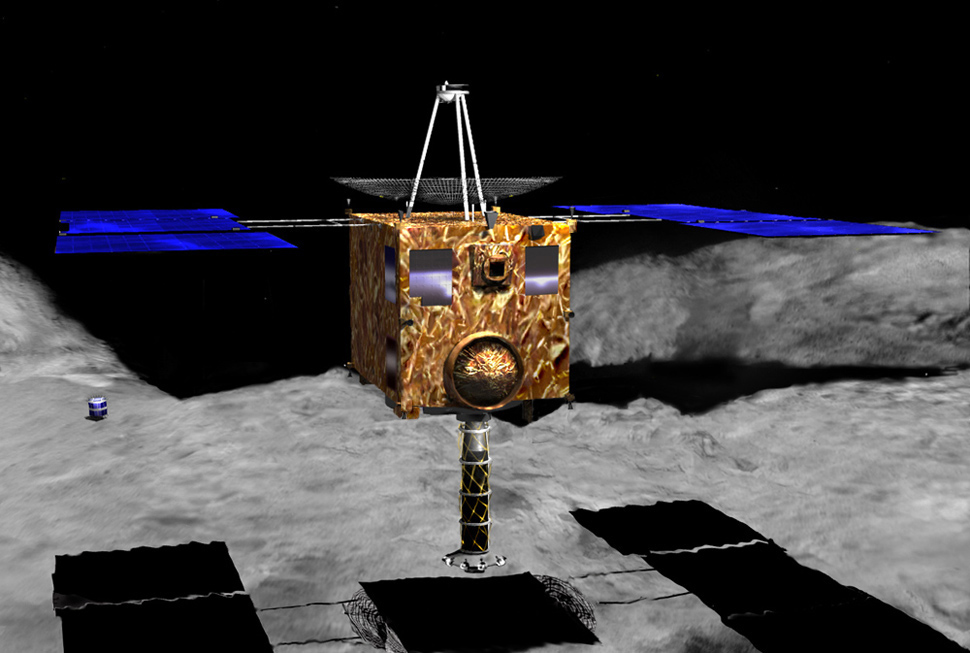Ten years ago today — May 9, 2003 — Japan launched a daring asteroid sample-return mission from the Uchinoura Space Center, atop an M-5 rocket.

(Hayabusa. Image from the National Space Science Data Center.)
Originally called Muses-C, Hayabusa (“Falcon”) was a difficult mission to begin with, but experienced a series of setbacks that made its ultimate success all the more impressive.
- In late 2003, a large solar flare degraded the spacecraft’s solar panels, reducing the power available to its ion engines. The original rendezvous date in early summer 2005 was pushed back to September.
- On July 31, 2004, Hayabusa’s X-axis reaction wheel failed.
- The spacecraft successfully rendezvoused with 25143 Itokawa (1998 SF36) — an asteroid about as big as three football stadiums at 550 x 180 meters (1800 x 590 feet) — on September 12, 2005. Hayabusa established itself in a heliocentric orbit for station-keeping about 20 km (12.4 mi) from the asteroid.
- On October 3, 2005 Hayabusa’s Y-axis reaction wheel failed, leaving its attitude control subsystem operating only on “one reaction wheel and two chemical thrusters.”
- Hayabusa mapped the asteroid’s surface in two phases, then began descent operations. During the second touchdown rehearsal on November 12th, the spacecraft released a “lander/hopper” called Minerva; unfortunately, “the release was at a higher altitude than planned…. and it is believed Minerva moved off into space without landing.”
- A week later, on November 19, Hayabusa again descended toward the asteroid, and released a “target marker” before contact was lost as it fell to the surface.
Later telemetry indicated that Hayabusa hit the surface at 20:40 UT 19 November (5:40 a.m. JST 20 November) at roughly 10 cm/sec and bounced. It bounced again at 21:10 and then landed at 21:30 within about 30 meters of the target marker. At 21:58 (6:58 a.m. JST 20 November) it was commanded to make an emergency ascent. The craft remained on the surface for about half an hour but did not collect a sample. This was the first ever controlled landing on an asteroid and first ascent from any other solar system body except the Moon.
- On November 25, Hayabusa touched down again, and fired two “sampling bullets” at the surface. Telemetry could not verify that they actually fired; nevertheless, Hayabusa lifted off.
- On December 9, ground controllers lost contact with the spacecraft, “presumably because of torques caused by a thruster leak which altered the pointing of the antenna.”
- Controllers restored communication in March 2006, and learned over the next several months that the spacecraft’s status was somewhat grim: low on fuel, two out of three reaction wheels inoperative, plus 4 out of 11 batteries had also stopped working. The spacecraft’s degraded solar cells and batteries were still sufficient to maintain thrust and attitude control with its xenon ion engine, and in April 2007 it started its journey Earth-ward.
When Hayabusa was a little outside the Moon’s orbit, it released its sample return capsule, which de-orbited on June 13, 2010 and landed near Woomera, Australia.
Subsequent examination of the sample return capsule showed that there were roughly 1500 dust particles, presumably from asteroid Itokawa.
Well done, Hayabusa!
You can learn more about this remarkable mission at this Japan Aerospace Exploration Agency (JAXA) page.







